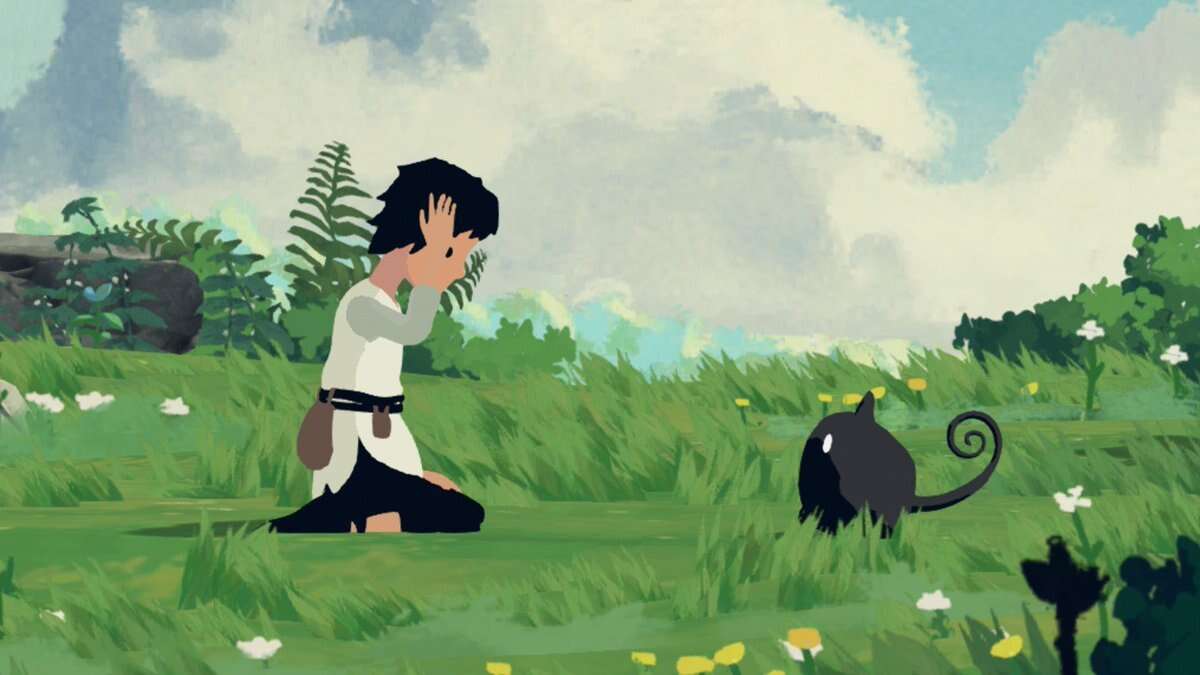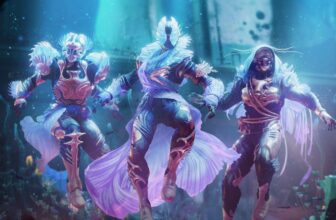
[adinserter block=”4″]
Planet of Lana begins in the quaint fishing village its titular protagonist calls home. As you chase after your older sister, stumbling at times–which elicits laughter from big sis–you’re afforded time to get to grips with the game’s 2D platforming, jumping and climbing over the wooden docks, platforms, and rooftops that make up this small but dense town. After passing through a bustling market where people are selling strawberries and freshly-caught fish, you sneak past a chef chopping up vegetables amid plumes of steam before passing by empty boats moored in the crystal-clear waters the town is built upon. It’s a moment of serenity that could be mistaken for a rural location on Earth, were it not for the all-encompassing moon dominating the sky. As you gradually make your way out of town and into the verdant hilltops nearby, this fleeting tranquility is shattered by the ominous sight of dozens of drop pods tumbling into the planet’s atmosphere.
Darting back through the village in the opposite direction is a harrowing experience, as an apocalyptic army of tinted-black robots begins rounding up any signs of life. The peaceful sound of waves crashing against the shore is violently replaced by people screaming and the unnatural bleeps of faceless colonizers, establishing a sharp contrast between tranquility and chaos. With her entire world turned upside down, Lana sets out on a seemingly impossible quest to rescue her captured sister and village, taking you on an enchanting four-hour adventure that’s inspired by cinematic puzzle-adventure games like Another World, Inside, and the Oddworld series. You can see bits and pieces of each of these games reflected in Planet of Lana’s gameplay, from its deliberate platforming to its logic and physics-based puzzle-solving. Yet it’s the animated movies of Studio Ghibli that serve as the primary influence for Swedish developer Wishfully–something that’s apparent right from the game’s first few seconds.
Opening up on a shot of the daytime sky, the vivid hand-painted art style immediately pulls you in and evokes movies such as Spirited Away and My Neighbor Totoro without trying to replicate their exact style. Objects closer to the screen are coated in finer detail, for instance, while the vibrant backgrounds use broader, thicker brush strokes, creating a layered image that makes it feel like you’re inside an interactive painting. Just glancing at screenshots sells the game’s gorgeous aesthetic, but it looks equally stunning in motion, with trees swaying in the breeze, critters scurrying out of sight as you traverse through woodland, and ancient structures whirring to life after being dormant for decades–the world feels alive. The sense of scale is noteworthy, too, not just from a visual standpoint, but because of the way it gives perspective to the scope of Lana’s task. The giant robot mothership that initially looms in the distance gradually consumes more and more of the horizon as you inch closer to its foreboding structure, providing a visible landmark for your journey’s progress.
Other games have adopted a Ghibli-esque aesthetic before, but Planet of Lana takes it a step further by employing a familiar tone–one that’s light and colorful while also tackling complex subjects–and exploring similar themes and ideas as the Japanese animation studio. The relationship between animals, nature, and humans is one of the story’s more prominent motifs, examining how imbalance and disharmony benefit neither the planet nor its inhabitants. Delving into environmentalist themes feels particularly Ghibli-inspired, and it’s especially thought-provoking and reflective considering the real world’s environmental crisis. Clues about the history of the planet are also scattered throughout the game, with cryptic cave paintings and secret shrines forming a picture of the past and what led to current events. The game never spells any of this out, mind you; it’s an ode to visual storytelling and a “show don’t tell” approach that keeps you engaged by constantly raising questions about the planet’s enticing mysteries.
However, it’s the burgeoning relationship between Lana and her companion Mui that’s the beating heart of the game. Mui is one of the planet’s many indigenous species–a small, inky-black creature best described as a mix between a cat and a monkey. The pair meet not long after Lana sets off on her perilous quest, and it’s this peril that brings the two together as they quickly form an inseparable bond. Both characters have their own strengths and limitations, but you soon learn that, together, they complete each other, creating a relationship built on mutual dependency. This informs many of Planet of Lana’s puzzles, with Lana able to issue basic commands to Mui in order to navigate the plethora of obstacles you come up against.
Other games have adopted a Ghibli-esque aesthetic before, but Planet of Lana takes it a step further by employing a familiar tone–one that’s light and colorful while also tackling complex subjects
Mui is nimble and able to leap great heights to reach distant ropes and levers to help Lana scale cliff faces and other hurdles. They also have a connection with the planet’s menagerie of other creatures, able to unfurl alien ledges by standing on tentacle-covered pressure plates or take control of larger beasts to move them out of the way. Lana, on the other hand, can drag heavy objects and help Mui cross bodies of water since the little critter is deathly afraid of the stuff. It’s this dynamic that separates Planet of Lana from its inspirations and really impresses upon you how much both characters need each other to see this quest through to the end. You can tell Mui to stop, follow, and interact with context-sensitive objects, or use a cursor to instruct them to stand in a particular spot. Getting this cursor to land on the spot you’re aiming at can be a tad finicky at times, but this is a minor gripe that doesn’t detract from how easy it is to fall in love with the bond the two share.
It’s apparent how much Lana and Mui care about one another, and all of this is masterfully conveyed without any intelligible dialogue. Characters in Planet of Lana speak in a fictional alien language, so characterization is achieved with a combination of body language and tone of voice. The fantastic score–composed by Takeshi Furukawa, whose previous work includes The Last Guardian–also does a lot to sweep you up in their relationship with an emotive orchestral soundtrack that swells and pulls at the heartstrings.
You also feel a fierce sense of responsibility to protect both characters because of their tangible vulnerability. Lana always feels distinctly human due to the fact that she’s incapable of leaping across massive chasms or surviving lengthy falls. This not only makes her endearing but also increases the tension that occurs when dealing with particularly dangerous situations. You can’t fight back against the invading machines directly, so there are times when you have to use stealth to circumnavigate danger by crouching in tall grass or darting through tunnels. Other times, you have to make the frightening decision to attract an enemy toward one character to give the other time to solve a puzzle. Figuring out how to get past each metal foe is a conundrum in and of itself, and there’s some trial and error involved because the machines won’t hesitate to end the life of either Lana or Mui if they’re spotted. This doesn’t usually result in frustration because the majority of checkpoints are fairly generous, but there are a few moments where death forces you to repeat some drawn-out sequences over again–which is only exacerbated by Lana’s slow movement.
Most of the puzzles are challenging in different ways, demanding reasoning, precise timing, and platforming prowess to complete, whether you’re dealing with unpredictable enemies, using physics to manipulate objects, or utilizing the environment to figure out how primitive technology functions. Repetition is an occasional nuisance, however. There are only so many times you can command Mui to reach a rope or swim across water using a log as a flotation device before these acts grow tiresome. Variety is prevalent to a certain degree, but it still goes back to the same well a few too many times.
Gallery
Outside of these puzzles, Planet of Lana sometimes shifts into action-packed sequences which require you to complete simple quick-time events. Each of these moments naturally fits into the flow of the narrative, and the cinematography throughout is fantastic. One memorable chase scene through the desert sees the camera weaving in and out to capture the thrilling speed of the action, while occasionally withdrawing into the distance to reveal the vast landscape and confluence of enemies on your tail. This sequence gets the adrenaline pumping and sets you up for a finale that’s full of spectacle and emotionally-fuelled highs and lows.
Developer Wishfully clearly has an eye for the cinematic, charting a planetary voyage that’s both suspenseful and heartfelt. Planet of Lana is about the bond between a young girl and her loyal companion, and also our own relationship with nature and our planet. It falters at times, miring through occasional tedium, but the strong connection it cultivates between its characters carries it forward as you delve into a variety of engaging puzzles and a gorgeous art style that breathes its strange but familiar world to life. Planet of Lana might not be the very best game released this year, but it will persevere as one of the most memorable.
[adinserter block=”4″]
Credit : Source Post






